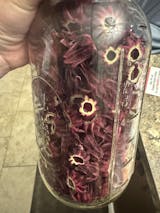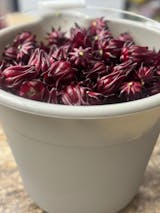St. Kitts Roselle Hibiscus
- St. Kitts Roselle - Unique variety shared by Turkey Hill Farm, Tallahassee, FL.
- Matures based on days to maturity, not daylight length, for higher productivity.
- Produces larger calyxes compared to other varieties.
- Ideal for the southern U.S.
- Thrives in full sun with 4-6 ft spacing.
- Can be direct-seeded or grown from transplants after frost danger.
- Hibiscus sabdariffa.
- 90 days to maturity.
Description
Be sure to check out our Roselle Growing Guide for more tips & tricks on successfully growing roselle in your garden.
Roselle Hibiscus is an heirloom, open-pollinated flower variety that produces loads of edible calyces that are great for making teas, jams, sauces, and more! This plant is in the Mallow family and is closely related to okra, cotton, and traditional flowering hibiscus plants. It is also called Red Sorrel, Jamaican Sorrel and Florida Cranberry in some regions. Harvest the calyces prior to opening for a delicious, tart treat that is great for you!
Once the seed pods are harvested, pull the dark red calyces from the seed pod. While they can be eaten raw, they make an incredible summer drink. The calyces may be dehydrated for later use, or use a mortar and pestle to release the flavors for making cold teas, tart jams, and sauces for almost any cooking application.
Roselle may be grown as a perennial in zones where freezing temperatures do not occur. In zone 8 and north, it is grown as a warm-season annual that will eventually be killed when the first frost arrives in fall/winter. Much like okra, it prefers warm temperatures and will thrive in the summer months.
Roselle Hibiscus can be direct-seeded or transplanted. Seeds prefer warmer soil temps for optimal germination, so transplanting will allow for earlier plantings than direct-seeding. Roselle seedlings grow great in our 162 Cell Seed Starting Trays and can be transplanted as soon as plants can be easily pulled from the seed starting tray.
Transplant Roselle seedlings into the garden with plants spaced approximately every 2-3 feet along the row. The plants can get quite large and quite bushy, so a row spacing of 4-5' feet should be used if planting multiple or adjacent rows. Plants will reach 6-7' tall at full maturity and continually produce edible calyces until cool weather arrives. One plant may produce up to 12 lbs of calyces per plant during the warm-growing season.
As is the case with okra, Roselle plants typically don't have any insect or disease pressure. However, because they're in the mallow family, they can be a target for root knot nematodes. As a result, one should practice proper crop rotation when growing Roselle. Don't plant members of the mallow family in the same location in subsequent years.
Roselle Hibiscus Planting Information
Planting Method: transplant or direct seed
When to Plant: after last frost
Planting Depth: 1/3″
Seed Spacing: 24″
Row Spacing: 4-5′
Days to Maturity: 90
Disease Resistance: None






